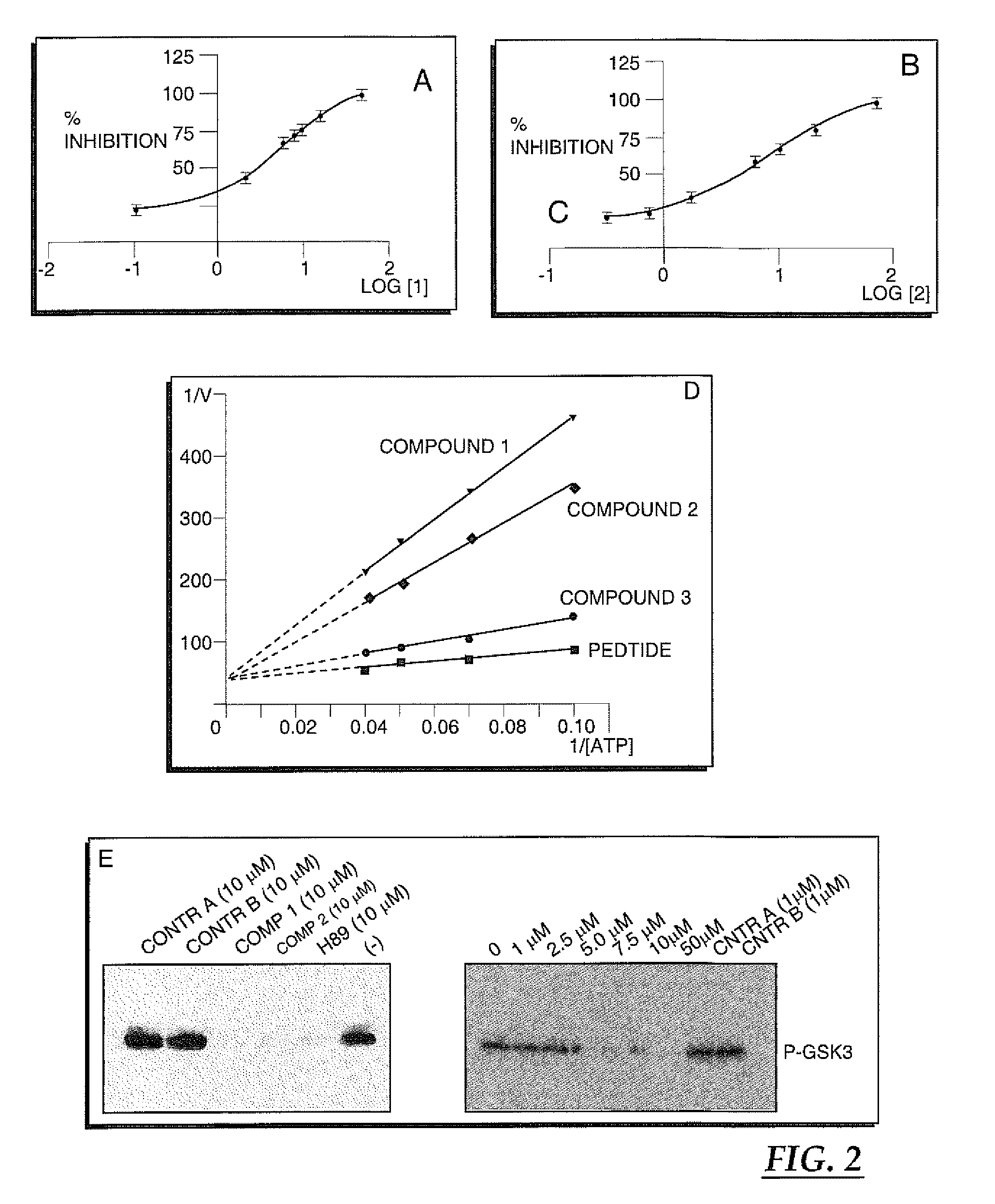Selective inhibitors of akt and methods of using same
a protein kinase and inhibitor technology, applied in the direction of biocide, heterocyclic compound active ingredients, drug compositions, etc., can solve the problems of inappropriate regulation of apoptosis and uncontrolled cell growth, and achieve the effect of reducing tumor siz
- Summary
- Abstract
- Description
- Claims
- Application Information
AI Technical Summary
Benefits of technology
Problems solved by technology
Method used
Image
Examples
example 1
Selecting Akt1 Inhibitors
[0123]Nowadays, high-throughput screening of large chemical databases is a common approach for lead identification. However given the 3D structure of the protein target, it should be possible to restrict the number of compounds to be tested by using computational docking studies.
[0124]In this Example, we describe a number of approaches based on the reported crystal structure of Akt1 kinase. This methodology allowed us to select several potential inhibitors on the basis of their predicted ability of docking into the ATP binding site.
[0125]A target binding site was derived from the crystal structure of the ternary complex involving Akt1, non-hydrolyzable form of ATP (AMP-PNP pdb id: 1O6K) and the peptide-substrate derived from GSK-313 (10). The protein active site was defined including those residues within 6.5 Å from the ATP mimic. Hydrogen atoms were calculated using Sybyl (11) (Tripos, St. Louis, Mo.) and water molecules, peptide substrate as well as the AT...
example 2
Identification of BI-69A11 as AKT Inhibitor
[0138]We recently reported on the direct evaluation of a number of in silico approaches to identify AKT inhibitors (Forino et al., 2005) We achieved experimental validation of selected compounds using both a fluorescence-based enzymatic assay and a substrate phosphorylation assay involving the protein GSK-3 (Forino et al., 2005). Briefly, the virtual docking approach consists of selecting the top 4,000 out of 50,000 docked compounds, using a variety of computational docking approaches, including a consensus score among two different scoring functions (Forino et al., 2005). Of those, 100 compounds were selected based on ranking and favorable docking geometry. Finally, 2 compounds were selected for further evaluation based on their ability to inhibit AKT activity with IC50 values in the low micromolar range. Compound BI-69A11 (FIG. 4) inhibited AKT1 in a concentration range comparable to that of H-89, a commercially available AKT inhibitor, y...
example 3
Characterization of BI-69A11 in Melanoma Cells
[0140]To evaluate the effectiveness of BI-69A11 on melanoma cells we assessed the effect of different concentrations on AKT phosphorylation in MeWO cells. While low doses (<0.3 micro.M) did not affect AKT phosphorylation, a dose of 3 micro.M BI-69A11 caused partial inhibition of AKT phosphorylation on 5473, which serves as a marker for AKT activity (FIG. 5A). Analysis of cell death revealed that about 60% of the melanoma cells were dead within 24 hours after treatment with the 3 micro.M dose of BI-69A11 (FIG. 5B). These data provide initial support for the effectiveness of this inhibitor on AKT phosphorylation and melanoma cell death.
[0141]To substantiate these initial findings we have set to compare the effect of the BI-69A11 on AKT phosphorylation and cell death among melanoma, prostate and breast tumor cell lines. Since the concentration of 3 micro.M caused partial inhibition of AKT phosphorylation, we have now compared the effect of ...
PUM
| Property | Measurement | Unit |
|---|---|---|
| pharmaceutical composition | aaaaa | aaaaa |
| PH | aaaaa | aaaaa |
| crystal structure | aaaaa | aaaaa |
Abstract
Description
Claims
Application Information
 Login to View More
Login to View More - R&D
- Intellectual Property
- Life Sciences
- Materials
- Tech Scout
- Unparalleled Data Quality
- Higher Quality Content
- 60% Fewer Hallucinations
Browse by: Latest US Patents, China's latest patents, Technical Efficacy Thesaurus, Application Domain, Technology Topic, Popular Technical Reports.
© 2025 PatSnap. All rights reserved.Legal|Privacy policy|Modern Slavery Act Transparency Statement|Sitemap|About US| Contact US: help@patsnap.com



